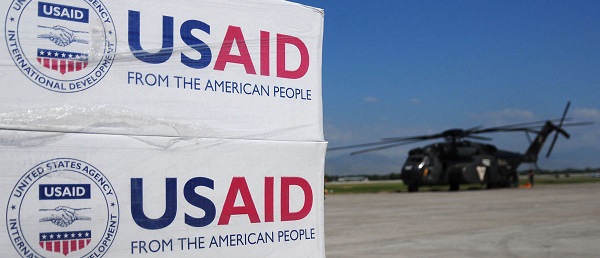illegal immigration
UN Budgets Millions for U.S.-Bound Migrants in 2024
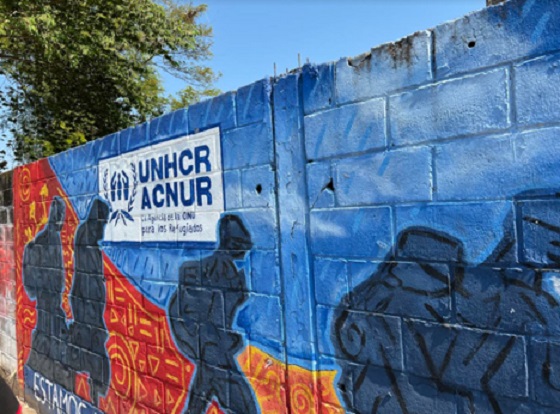
As this mural in Tapachula, Mexico, shows, UN agencies are well aware that their cash aid and assistance helps support illegal immigration over the U.S. southern border. January 2022 photo by Todd Bensman.
From the Center for Immigration Studies
By Todd Bensman
Public docs show cash handouts to help feed, transport, and house people headed for the U.S. border
Early on in America’s historic border crisis, now entering its fourth record-smashing year, some Republican lawmakers named a significant enabling culprit other than the usual Mexican cartel smugglers. They named the U.S. taxpayer-funded United Nations as essentially a co-smuggler after seeing my reports that the UN was handing out debit cards and cash vouchers to aspiring illegal border crossers on their way north.
One outraged group of 21 border-security-minded lawmakers even pitched a bill that would require the United States, the UN’s largest donor, to turn off the taxpayer money spigot. H.R. 6155 never caught fire, though, in no small part because “fact checks” claiming to debunk other reports like mine in the conservative press dissuaded broader media interest and left the American public in the dark.
But now the UN’s 2024 update to the “Regional Refugee and Migrant Response Plan” (RMRP for short), a planning and budget document for handing out nearly $1.6 billion in 17 Latin America countries, can cast a broad confirming light on the cash giveaways and much more aid for 2024 ahead — with the helping hands of 248 named non-governmental organizations. Despite the RMRP plan title naming Venezuelans as recipients of this aid operation, the document’s fine print (footnote on p. 14 and paragraph on p. 43, for instance) says the largesse goes to “all nationalities” and “multiple other nationalities”.

A Haitian shows his UN cash card outside a UN facility in Tapachula. He was there to complain the agency had not deposited money in the depleted card. January 2022 photo by Todd Bensman.
The documents clear up any mystery about what the UN and NGOs are doing on the migrant trails and leave no room for supposedly debunking “fact checks”.
In a nutshell, the UN and its advocacy partners are planning to spread $372 million in “Cash and Voucher Assistance (CVA)”, and “Multipurpose Cash Assistance (MCA)” to some 624,000 immigrants in-transit to the United States during 2024. That money is most often handed out, other UN documents show, as pre-paid, rechargeable debit cards, but also hard “cash in envelopes”, bank transfers, and mobile transfers the U.S. border-bound travelers can use for whatever they want.
The $372 million in planned cash giveaways to the 624,000 immigrants moving north and illegally crossing national borders “represents a significantly greater share of the financial requirements” for 2024, the RMRP says, but it is still only one part of much broader UN hemisphere-wide vision that aims to spend $1.59 billion assisting about three million people in 17 countries who emigrated from their home nations. Most will be “in-destination” recipients already supposedly settled in third countries, albeit in declining numbers, but a rising share of cash will go to the spiking numbers of “in-transit” immigrants launching journeys from those accommodating countries north to the United States.

Cash cards going out to immigrants in long lines at a camp in Reynosa, Mexico, in September 2021, photos that first drew ostensibly debunking fact checks. Photos by Todd Bensman.
Without distinction, both populations get access to UN cash but also “humanitarian transportation”, shelter, food, legal advice, personal hygiene products, health care, and “protection” against threats like human smuggling, and much more besides cash in envelopes or debit cards.
The cash handouts will be in the mix during 2024 as the UN and its private partners incorporate an “increased use of CVA” in, for instance, the $184 million it plans to provide 1.2 million people, $122 million for rent support and also “temporary collective shelter” for 473,000 people, and $25.8 million for “humanitarian transportation” to 129,000 people crossing borders. There’ll also be “expanded use of multi-purpose cash” for those claiming “gender-based violence”.
The UN’s 2024 Game Plan
The 130-page UN-spearheaded RMRP 2024 update went public in December and is readily accessible online, as is the original 2023-2024 plan it revises — sharply upward. It is the latest since the United Nations High Commissioner for Refugees and the UN’s International Organization for Migration started the program in 2018, originally for Venezuelans but now open to anyone in 17 nations of Latin America and the Caribbean. (For the complete list of involved groups, see p. 268, here, and explore their activities further with this handy interactive tool).
Some 57 international organizations would manage the handouts of $273 million, while 132 “national NGOs” and “civil service organizations” would handle $70 million in aid. Fifteen UN agencies would get the lion’s share at $1.2 billion.
The NGOs actively participated in crafting the RMRP 2024 Update, which amends a 2023-2024 plan released back in 2022 that at the time foresaw a decline in illegal immigration after 2023. It increased, instead.

A Nicaraguan on his way to the U.S. showed his UN cash card in Monterrey, Mexico. January 2022 photo by Todd Bensman.
“Country-level projections of in-transit movements for populations moving north through Central America and Mexico have been revised sharply upwards,” p. 44 explains in updating the 2024 RMRP update.
The reasons given include factors like “xenophobia” leading resettled migrants to leave for the United States. It does, finally, tag the real culprit: U.S. policies that created “newly established opportunities for regular pathways to move to the United States of America” for those who could make their way to northern Mexico.
The document makes clear in writing that the UN and these partners know their endeavor aids, abets, and makes possible the “onward movement” of immigrants who intend to illegally cross borders, especially to get into the United States.
None of them care. Twenty new groups joined the UN endeavor for 2024 for a total of 248.

Their plan frequently acknowledges the illegality, saying for instance, that one in three of the Venezuelan migrants the UN aims to help are in “irregular situations”, including those “who have crossed international borders without complying with all the legal and administrative requirements for entry and may not have the required documentation to do so”, as well as visa overstayers. The original 2023-2024 plan even spelled out that “special attention will be given to the use of [cash and voucher assistance] for in-transit populations, including the need for comprehensive solutions throughout the journey”.
The only expression of apparent concern about supporting people clearly intending to break U.S. law shows up on a page depicting a map with the thin red line of a migration route leading to the U.S. border at about El Paso. Someone took the trouble to add a footnote on that page noting that the map “does not imply official endorsement or acceptance by the UN”.

UN workers help long lines of immigrants apply for aid in Tapachula, Mexico. Photos by Todd Bensman.
Why hand out hundreds of millions of dollars as cash and services to hundreds of thousands planning to illegally follow that red line through UN member states, to include crossing the US border, when those nations don’t like or want it and must bear the political controversies of it?
“To support access to asylum procedures, migratory regularization activities, and socio-economic integration”, the plan says.
The money handout program “has taken on increasing importance”, it explains elsewhere, because it gives growing numbers of immigrants “the flexibility to cover their expenses and needs they deem most urgent, increasing their dignity and autonomy”.
Where It’ll Be Doled Out
Over the past three years, I have visited UN waystations featuring long lines of U.S.-bound immigrants applying for aid from clipboard-wielding workers handing out cash cards and other goodies, from Reynosa and Monterrey in the north of Mexico to Tapachula in the far south. But the waystations also appear everywhere along the trails much farther south.
The RMRP plan calls for distributing most of the cash, cash equivalents, and vouchers to migrants in Colombia and Ecuador, which are launch pads that sent 450,000 people through the Darian Gap jungle passage in Panama. The plan calls for 24 NGO partners to give money to 95,000 in Colombia and 59,000 in Mexico.
Some of the so-called transportation assistance is for local cab rides to stores or doctor appointments. But the UN agencies also know that aid will facilitate “increased onward movements” between countries of the “in-transit population” for 105,000 immigrants in Colombia, 25,000 in Brazil, 13,000 in Panama, and 3,700 in Mexico, to name a few places.
Likewise for “shelter”, $27.5 million is earmarked for 161,000 travelers in Colombia, $22.5 million for 179,000 in Ecuador, $18 million for 165,000 in Peru, and $4.3 million to help 33,000 in Mexico.
Political Fight or Flight
In years one and two of the historic mass migration crisis that President Biden’s let-them-all-in policies triggered, Republicans in the U.S. House of Representatives spoiled for a political fight over UN and NGO activity along the migrant routes because it was funded largely and ironically by the United States. And not just them. In December 2022, Texas Gov. Greg Abbott wrote Attorney General Ken Paxton asking him to investigate whether non-governmental organizations unlawfully assisted mass border crossings that overwhelmed the El Paso region.
Recent Congressional Research Service reporting reminds us that they had some legitimate grounds to complain; the United States has been the largest financial contributor to UN entities since the UN was established in 1945. Congress and the executive branch play key roles; Congress appropriates U.S. funding, while the executive branch shapes where the money will go through the State Department and the U.S. Mission to the United Nations in New York City.
Complaints, questions, and proposed legislation about the UN’s role in all of this may have gone cold, but as the latest RMRP plan reveals, the world body is as hot on the trail as ever.
Prior to his government experience, Bensman worked on staff for The Dallas Morning News, CBS, and Hearst Newspapers, covering the FBI, federal law enforcement and serving on investigative teams. He reported extensively on national security issues after 9/11 and worked from more than 25 countries in Latin America, the Middle East, and Africa. In Texas, he authored long-form investigative stories with emphases on border security related to illegal immigration and Mexico’s drug war. His reporting on human smuggling from Muslim-majority countries, Mexico’s drug war, and cross-border gun smuggling to cartels earned two National Press Club awards and an Inter-American Press Association award, among others.
Crime
Sweeping Boston Indictment Points to Vast Chinese Narco-Smuggling and Illegal Alien Labor Plot via Mexican Border
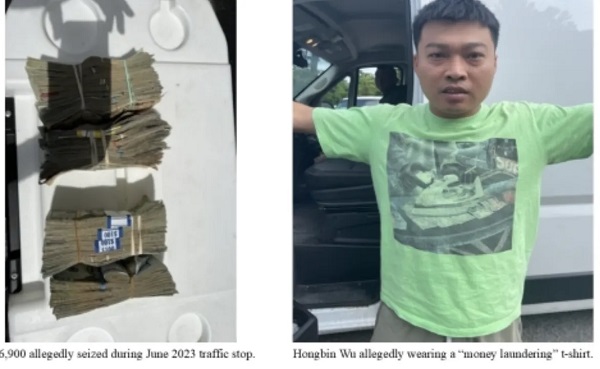
 Sam Cooper
Sam Cooper
Case details a pipeline from China through Mexico, trapping trafficked illegal migrants as indentured workers in a sweeping drug network.
In a sweeping indictment that tears into an underworld of Chinese narco infiltration of North American cities — including the smuggling of impoverished Chinese nationals across the Mexican border to work as drug debt slaves in illegal drug houses — seven Chinese nationals living in Massachusetts stand accused of running a sprawling, multimillion-dollar marijuana trafficking and money laundering network across New England.
The backdrop of the human smuggling allegations stretches back to 2020, as an unprecedented wave of illegal Chinese migrants surged across the U.S. border with Mexico — a surge that peaked in 2024 under the Biden administration before the White House reversed course. This explosive migration trend became a flashpoint in heated U.S. election debates, fueling concerns over border security and transnational organized crime.
Six of the accused, including alleged ringleader Jianxiong Chen of Braintree, were arrested this week in coordinated FBI raids across Massachusetts. The border exploitation schemes match exactly with decades-long human smuggling and Chinese Triad criminal pipelines into America reported by The Bureau last summer, based on leaked intelligence documents filed by a Canadian immigration official in 1993. A seventh suspect in the new U.S. indictment, Yanrong Zhu, remains a fugitive and is believed to be moving between Greenfield, Massachusetts, and Brooklyn, New York.
The case paints a striking portrait of China-based criminal organizations operating behind the quiet facades of upscale American suburban properties. Prosecutors allege the defendants owned or partnered with a network of sophisticated indoor grow houses hidden inside single-family residences in Massachusetts, Maine, and beyond, producing kilogram-scale shipments of marijuana. According to court documents, the marijuana was sold in bulk to distributors across the Northeast, and the profits — amounting to millions — were funneled into luxury real estate, cars, jewelry, and further expansion of their illicit operations.
“During a search of [ringleader Chen’s] home in October 2024, over $270,000 in cash was allegedly recovered from the house and from a Porsche in the driveway,” the indictment alleges, “as well as several Chinese passports and other identification documents inside a safe.”
According to the indictment, Chen’s cell phone data confirmed his personal role in orchestrating smuggling logistics and controlling workers. Additional searches of homes where co-defendants lived yielded over 109 kilograms of marijuana, nearly $200,000 in cash, and luxury items including a $65,000 gold Rolex with the price tag still attached.
A photo from the indictment, humorously but damningly, shows alleged ring member Hongbin Wu, 35, wearing a green “money laundering” T-shirt printed with an image of a hot iron pressing U.S. dollar bills on an ironing board — a snapshot that encapsulates the brazenness of the alleged scheme.
Key to FBI allegations of stunning sophistication tying together Chinese narcos along the U.S. East Coast with bases in mainland China is a document allegedly shared among the conspirators.
“The grow house operators maintained contact with each other through a list of marijuana cultivators and distributors from or with ties to China in the region called the ‘East Coast Contact List,’” the indictment alleges.
Investigators say the conspiracy reveals a human smuggling component directly tied to China’s underground migration and debt bondage networks, mirroring exactly the historic intelligence from Canadian and U.S. Homeland Security documents reported by The Bureau last summer.
The alleged leader, 39-year-old Jianxiong Chen, is charged with paying to smuggle Chinese nationals across the Mexican border, then forcing them to work in grow houses while withholding their passports until they repaid enormous smuggling debts.
“Data extracted from Chen’s cell phone allegedly revealed that he helped smuggle Chinese nationals into the United States — putting the aliens to work at one of the grow houses he controlled,” U.S. filings say.
“This case pulls back the curtain on a sprawling criminal enterprise that exploited our immigration system and our communities for personal gain,” said U.S. Attorney Leah Foley. “These defendants allegedly turned quiet homes across the Northeast into hubs for a criminal enterprise — building a multi-million-dollar black-market operation off the backs of an illegal workforce and using our neighborhoods as cover.”
The arrests come amid a surge of Chinese migrants entering the U.S. through Mexico, part of a pattern previously exposed in Canadian diplomatic and intelligence reporting. In 1993, a confidential Canadian government study, “Passports of Convenience,” warned that Chinese government officials, in collusion with Triads and corrupt Latin American partners, were driving a multi-billion-dollar human smuggling business. That report predicted that tens of thousands of migrants from coastal Fujian province would flood North America, empowered by Beijing’s tacit support and organized crime’s global reach.
It also warned that mass migration from China in the 1990s came during a time of political upheaval, a trend that has apparently re-emerged while President Xi Jinping’s economic and political guidance has been increasingly questioned among mainland citizens, particularly since the Covid-19 pandemic crisis and lockdowns inside China.
The 1993 report, obtained and analyzed exclusively by The Bureau, described how the Triads — particularly those connected with Chinese Communist networks in Fujian — would leverage human smuggling to extend their influence into American cities. The migrants, often saddled with debts of $50,000 or more, became trapped in forced labor, prostitution, or drug networks, coerced to repay their passage fees.
“Alien smuggling is closely linked to narcotics smuggling; many of the persons smuggled in have to resort to prostitution or drug dealing to pay the smugglers,” the 1993 Canadian immigration report says.

Citing legal filings in one U.S. Homeland Security case, it says a Triad member who reportedly smuggled 150 Fujianese migrants into New York stated that if fees aren’t paid “the victims are often tortured until the money is paid.”
Supporting these early warnings, a 1995 U.S. Department of Justice report echoed the Canadian findings, stating that “up to 100,000 Chinese aliens are smuggled into the United States each year,” with 85 percent originating from Fujian. The DOJ report also cited allegations of “negotiations between the Sun Yee On Triad and the Mainland Chinese Government,” suggesting that smuggling and criminal infiltration were tolerated — if not orchestrated — to extend China’s economic and political influence abroad.
That report added American investigators and immigration officials concluded it was nearly impossible to counter waves of illegal immigration from China with deportation orders, and the government should focus on “the larger menace working its way into U.S. cities: Chinese transnational criminal organizations.”
“To combat the growing threat of Asian organized crime in the West,” it says, “law enforcement officials must tackle this new global problem through an understanding of the Triad system and the nature of its threat to Western countries.”
In New England, the Braintree indictment shows how those old predictions have not only materialized but scaled up.
These networks operate by embedding Chinese nationals into illicit industries in North America, from black-market cannabis cultivation to high-end money laundering. Once inside, they channel profits back through complex underground banking channels that tie the North American drug economy to China’s export-driven cash flows and, ultimately, to powerful actors in Beijing.
In recent years, Maine has emerged as a strategic hotspot for illicit Chinese-controlled marijuana operations. As The Bureau has reported, the state’s vast rural areas, lax local oversight, and proximity to East Coast urban markets have made it a favored location for covert grow houses.
illegal immigration
Heightened alert: Iranians in U.S. previously charged with support for terrorism
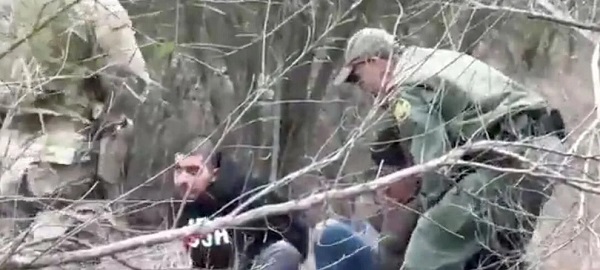
Texas Department of Public Safety brush team apprehends gotaways and smuggler in Hidalgo County.
From The Center Square
By
Prior to President Donald Trump authorizing targeted strikes against Iranian nuclear sites on Saturday, federal agents and Texas Department of Public Safety troopers have been arresting Iranian nationals, nearly all men, in the U.S. illegally. In the last few months, federal prosecutors have also brought terrorism charges against Iranians, including those in the U.S. working for the Iranian government.
Iran is a designated state sponsor of terrorism. Iranian nationals illegally in the country are considered “special interest aliens” under federal law.
The U.S. Department of Homeland Security on Sunday issued a warning to all Americans to be on a heightened threat alert.
“The ongoing Iran conflict is causing a heightened threat environment in the United States,” DHS warned. “Low-level cyber attacks against US networks by pro-Iranian hacktivists are likely, and cyber actors affiliated with the Iranian government may conduct attacks against US networks.
“Iran also has a long-standing commitment to target US Government officials it views as responsible for the death of an Iranian military commander killed in January 2020.”
U.S. officials have no idea how many Iranians are in the U.S. illegally because at least two million “gotaways” were recorded entering the U.S. during the Biden administration. Gotaways are those who illegally entered the U.S. between ports of entry who were not apprehended.
Key arrests include an Iranian living in the sanctuary jurisdiction of Natick, Mass., who is charged “with conspiring to export sophisticated electronic components from the United States to Iran in violation of U.S. export control and sanctions laws,” The Center Square reported. Authorities accuse the Iranian of illegally exporting the technological equipment to a company in Iran that contracts with the Islamic Revolutionary Guard Corps (IRGC), a US-designated foreign terrorist organization (FTO). The company allegedly manufactured drones used by the IRGC that killed U.S. soldiers stationed in Jordan.
Texas DPS troopers have arrested dozens of Iranian special interest aliens. Last October, DPS troopers questioned Iranians who illegally entered the U.S. near Eagle Pass, Texas, who said they came through Mexico and were headed to Florida, Las Vegas and San Francisco, The Center Square reported.
Last November and December, DPS troopers arrested Iranians in Maverick County after sounding the alarm about an increase of SIAs they were apprehending, The Center Square reported.
U.S. Customs and Border Protection and Immigration and Customs Enforcement officers also apprehended an Iranian with terrorist ties who illegally entered the U.S. near Buffalo, New York, The Center Square reported.
More recently, in April, two Iranians were charged in New York with conspiring to procure U.S. parts for Iranian drones, conspiring to provide material support to the IRGC and conspiring to commit money laundering. They remain at large. The charges “lay bare how U.S.-made technology ended up in the hands of the Iranian military to build attack drones,” DOJ National Security Division chief Sue Bai said.
Also in April, two Iranians and one Pakistani, were indicted in Virginia “for conspiring to provide and providing material support to Iran’s weapons of mass destruction program resulting in death and conspiring to commit violence against maritime navigation and maritime transport involving weapons of mass destruction resulting in death.” The Pakistani is awaiting trial; the Iranians remain at large.
Their involvement in maritime smuggling off the coast of Somalia led to the death of two Navy SEALs, according to the charges.
Also in April, a naturalized citizen working for the Federal Aviation Administration as a contractor pleaded guilty to charges of “acting and conspiring to act as an illegal agent of the Iranian government in the United States” for a period of five years. He was indicted last December in the District of Columbia for “infiltrating a U.S. agency with the intent of providing Iran with sensitive information,” including exfiltrating sensitive FAA documents to Iranian intelligence.
“The brazen acts of this defendant – acting against the United States while on U.S. soil – is a clear example of how our enemies are willing to take risks in order to do us harm,” U.S. Attorney Edward Martin said. “We want to remind anyone with access to our critical infrastructure about the importance of keeping that information out of the hands of our adversaries. I want to commend our prosecutors and law enforcement partners who secured a guilty plea that will keep our country safer.”
Also in April, an Iranian national was indicted in Ohio for operating a dark web marketplace selling methamphetamine, cocaine, fentanyl, heroin and oxycodone and other drugs; and for stealing financial information, using fraudulent identification documents, counterfeit currencies, and computer malware. Working with German and Lithuanian partners, he was charged, servers and other infrastructure were seized, and drugs and other contraband were stopped from entering the U.S., DOJ Criminal Division head Matthew Galeotti said.
Also in April, ICE Homeland Security Investigations in New York announced a civil forfeiture action halting an Iranian oil sale scheme that went on for years under the Biden administration.
The scheme involved facilitating the shipment, storage and sale of Iranian petroleum product owned by the National Iranian Oil Company for the benefit of the IRGC and Islamic Revolutionary Guard Corps, designated FTOs. The facilitators allegedly claimed the Iranian oil was from Malaysia, manipulated tanker identification information, falsified documents, paid storage fees in U.S. dollars and conducted transactions with U.S. financial institutions. The federal government seized $47 million in proceeds from the sale.
The complaint alleges they provided material support to the IRGC and IRGC-QF because profits support “proliferation of weapons of mass destruction and their means of delivery, support for terrorism, and both domestic and international human rights abuses.”
Last December, a federal court in the District of Columbia ordered the forfeiture of nearly $12 million connected with Iran’s illicit petroleum industry, involving Triliance Petrochemical Company, the IRGC and Quds Forces. FBI Tampa and Minneapolis were involved in the investigation.
Examples also exist of Iranians making false statements when applying for naturalization, including an Iranian in Tampa indicted last year.
-

 International2 days ago
International2 days agoSecret Service suspends six agents nearly a year after Trump assassination attempt
-

 Bruce Dowbiggin1 day ago
Bruce Dowbiggin1 day agoThe Covid 19 Disaster: When Do We Get The Apologies?
-

 Crime19 hours ago
Crime19 hours agoSweeping Boston Indictment Points to Vast Chinese Narco-Smuggling and Illegal Alien Labor Plot via Mexican Border
-

 Alberta1 day ago
Alberta1 day agoAlberta school boards required to meet new standards for school library materials with regard to sexual content
-
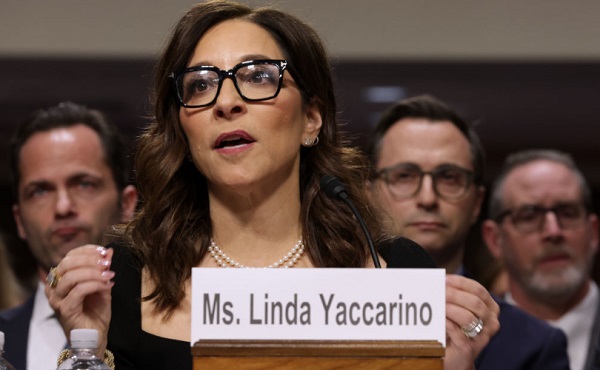
 Business2 days ago
Business2 days agoWEF-linked Linda Yaccarino to step down as CEO of X
-

 Automotive2 days ago
Automotive2 days agoAmerica’s EV Industry Must Now Compete On A Level Playing Field
-

 Environment19 hours ago
Environment19 hours agoEPA releases report on chemtrails, climate manipulation
-

 Business2 days ago
Business2 days ago‘Experts’ Warned Free Markets Would Ruin Argentina — Looks Like They Were Dead Wrong


